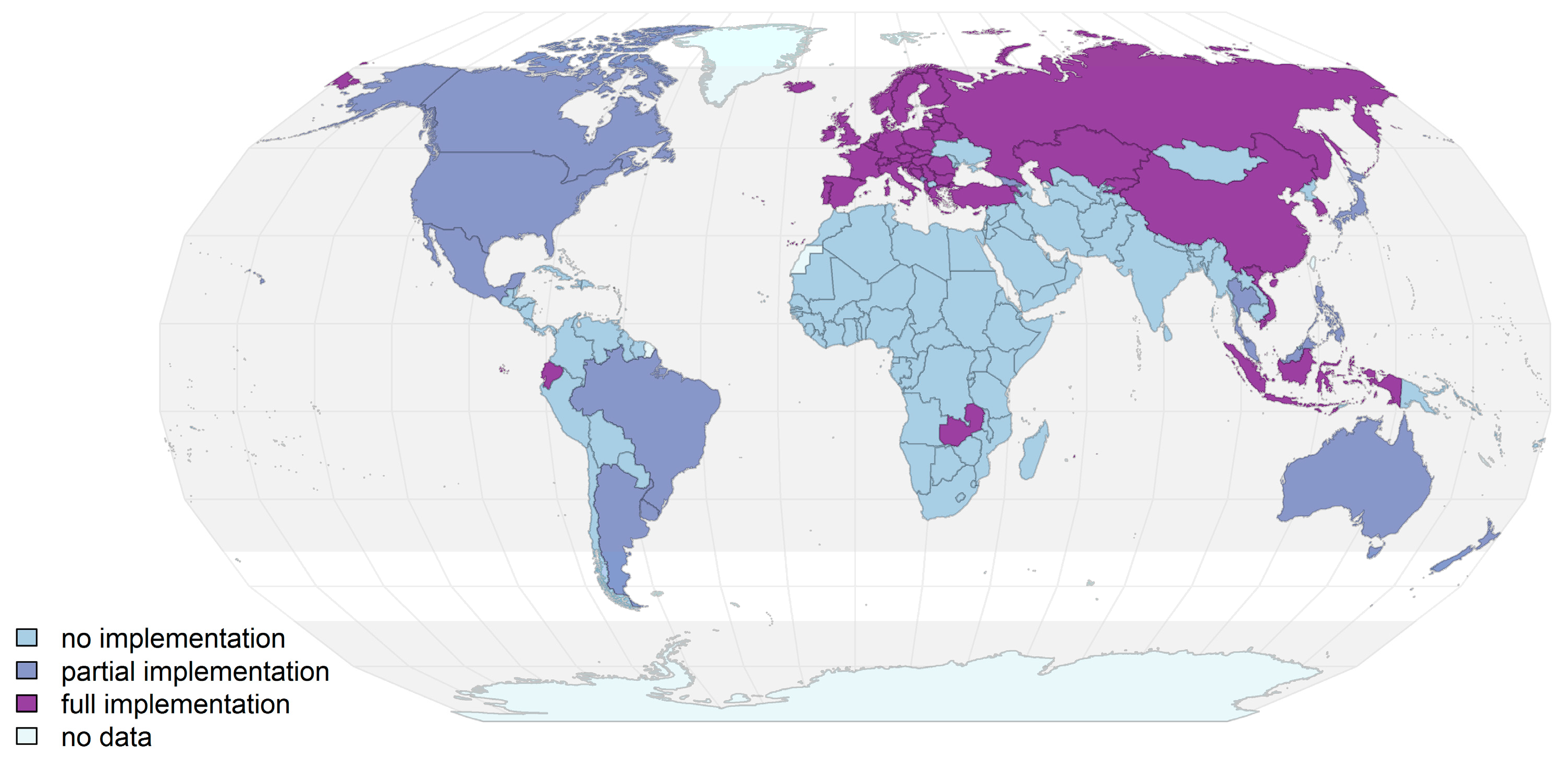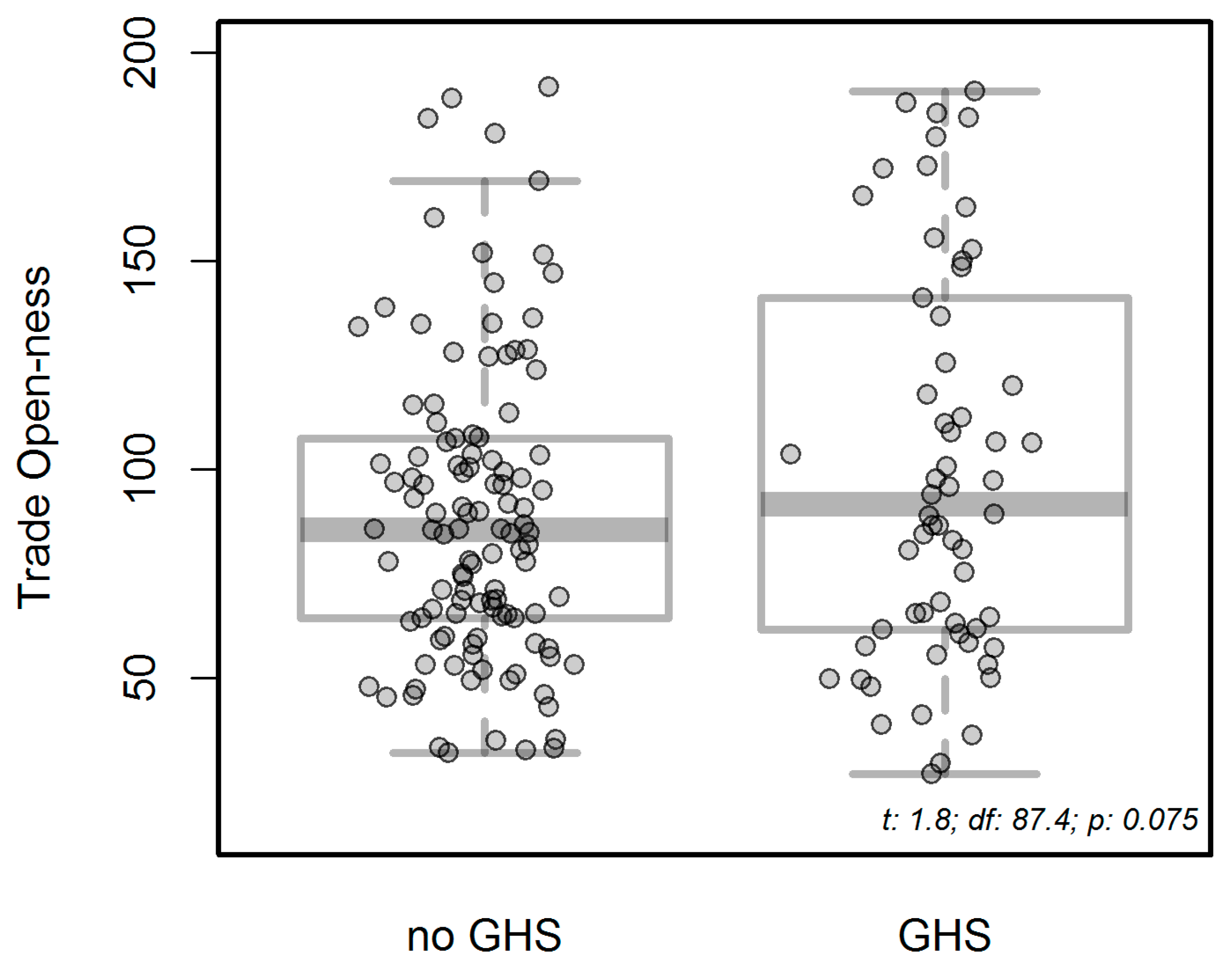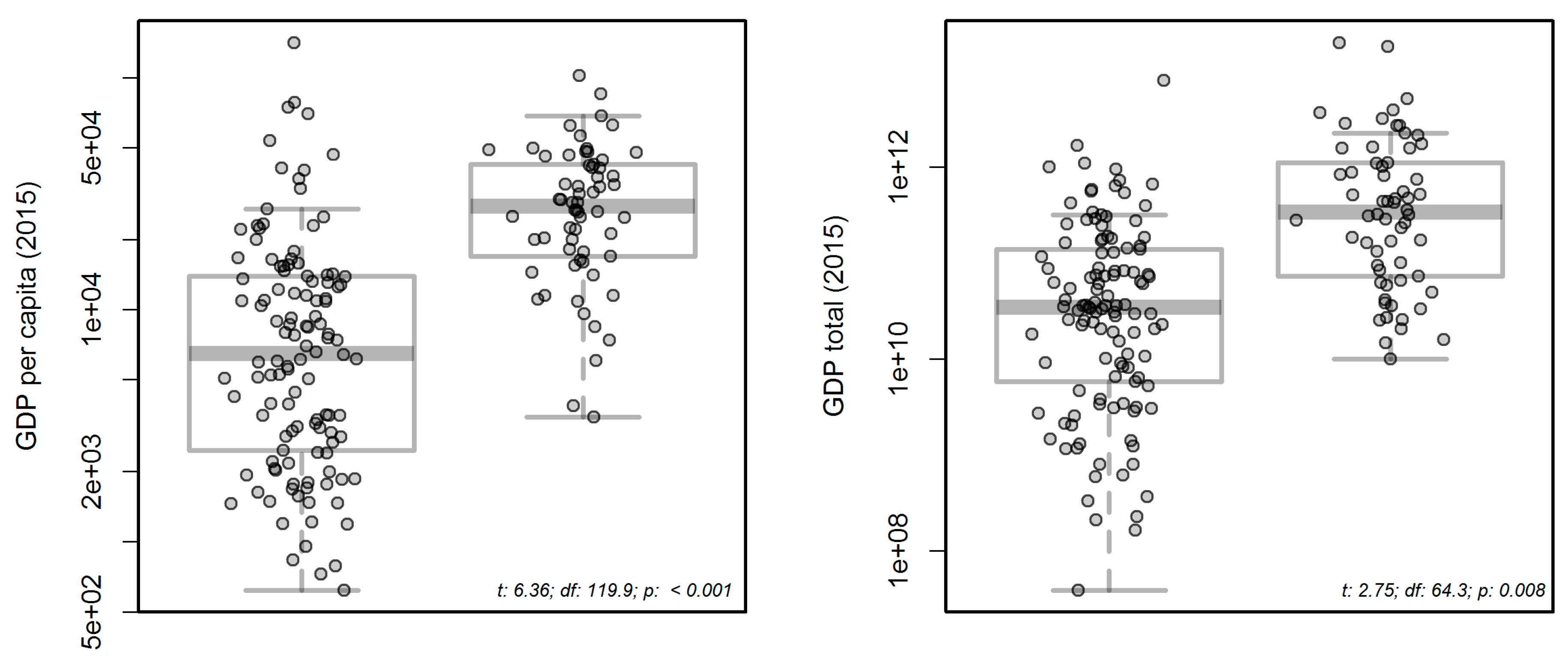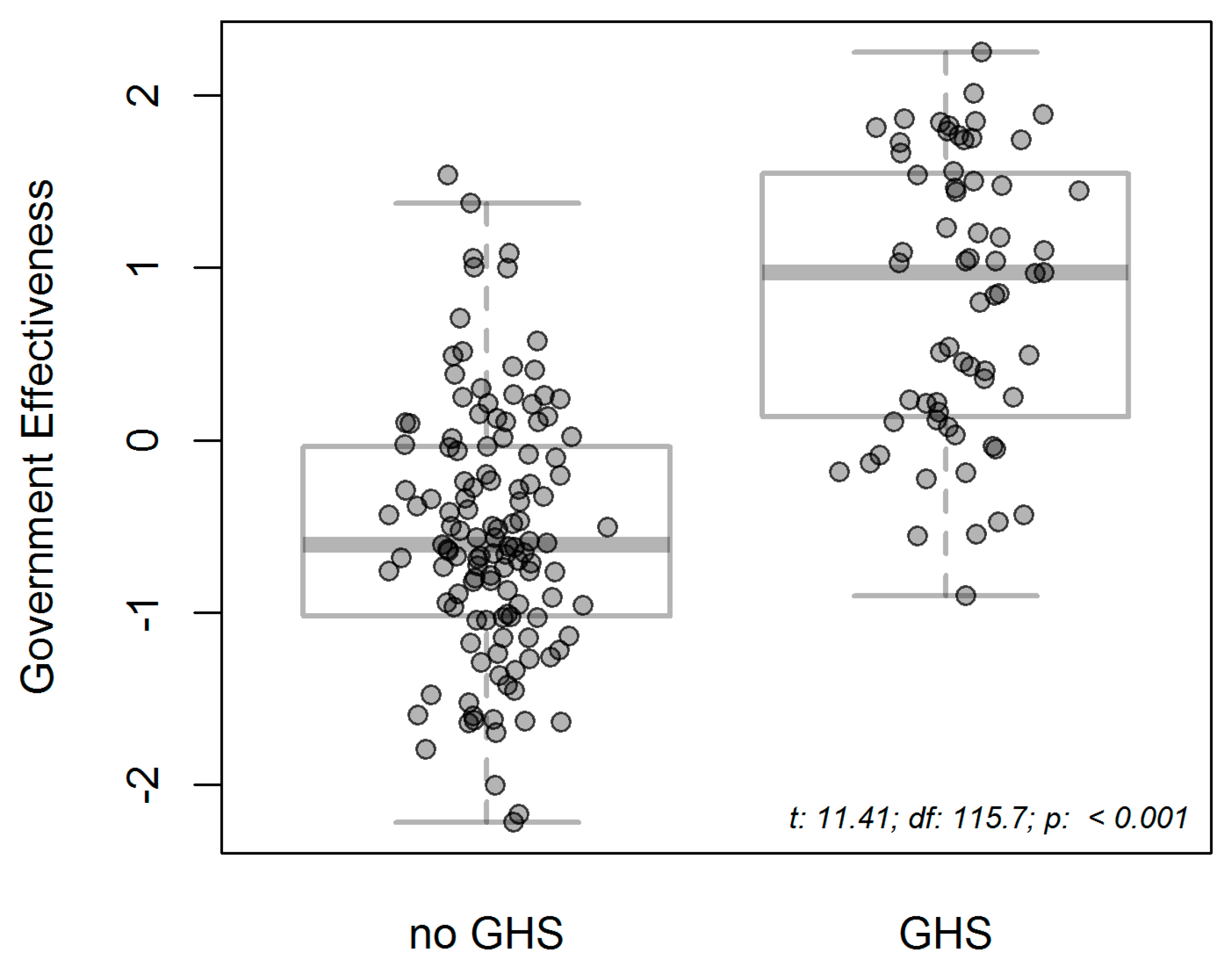The Globally Harmonized System of Classification and Labelling of Chemicals—Explaining the Legal Implementation Gap
Abstract
1. Introduction
2. Theory and Methods
2.1. GHS Implementation Status
- Full legal implementation (code 2): legislation passed as of 1 April 2017, irrespective of on which GHS revision the legislation is based, covering the workplace, agriculture and consumer sectors;
- Partial legal implementation (code 1): legislation passed as of 1 April 2017, covering at least one of the sectors agriculture, workplace or consumers;
- Not yet implemented in legislation (code 0): no legislation aligned with the GHS has been passed as of 1 April 2017, to our knowledge.
- Only binding legislation qualifies for “full” or “partial” legal implementation, whereas implementing GHS as a voluntary standard at the national level is classified as “not yet implemented”;
- If a country has passed legislation to implement GHS in all three sectors, the country is coded as fully implementing GHS, even if the legislation has not yet entered into force. Most countries who implement GHS do so in a stepwise manner and the majority of the GHS-implementing countries have introduced phase-in periods in the regulation with additional upcoming deadlines, e.g., for substances and mixtures;
- Even if GHS implementation is fully legally implemented in one sector, it does not qualify as “full legal implementation” if there are no legal requirements for the remaining two sectors;
- The scoring of countries’ implementation status is irrespective of which revision of GHS that has been introduced.
2.2. Method for Data Collection and Analysis
2.3. Understanding International Standardization
2.3.1. Motivational Factors
2.3.2. Capacity-Related Factors
3. Mapping of GHS Implementation
4. Exploring the Implementation Pattern
4.1. Motivational Factors
4.1.1. Reduction of Trade Barriers
4.1.2. Commitment to Occupational Safety
4.1.3. Commitment to the Sound Management of Chemicals
4.1.4. Commitment to International Cooperation
4.2. Capacity Related Factors
4.2.1. Financial Capacity
4.2.2. Regulatory Capacity
4.3. Comparison Across Indicators
5. Discussion and Conclusions
Supplementary Materials
Acknowledgments
Author Contributions
Conflicts of Interest
References
- Selin, H. Global Governance of Hazardous Chemicals: Challenges of Multilevel Management; Politics, Science, and the Environment; MIT Press: Cambridge, UK, 2010; ISBN 978-0-262-01395-6. [Google Scholar]
- Wexler, P.; van der Kolk, J.; Mohapatra, A.; Agarwal, R. (Eds.) Chemicals, Environment, Health: A Global Management Perspective; CRC Press: Boca Raton, FL, USA; Taylor and Francis: London, UK, 2011. [Google Scholar]
- United Nations Environment Programme (UNEP). Global Chemicals Outlook, towards Sound Management of Chemicals; United Nations Environment Programme: Nairobi, Kenya, 2013. [Google Scholar]
- UN GHSSC GHS Implementation, Secretariat of the Sub-Committee of Experts of the GHS (GHSSC). Available online: http://www.unece.org/trans/danger/publi/ghs/implementation_e.html (accessed on 1 April 2017).
- UNCED. Agenda 21. 1992. Available online: https://sustainabledevelopment.un.org/outcomedocuments/agenda21 (accessed on 23 November 2017).
- Pruss-Ustun, A.; Wolf, J.; Corvalan, C.; Bos, R.; Neira, M. Preventing Disease through Healthy Environments—A Global Assessment of the Burden of Disease from Environmental Risks; World Health Organisation: Geneva, Switzerland, 2016. [Google Scholar]
- United Nations Environment Programme (UNEP). Costs of Inaction on the Sound Management of Chemicals; United Nations Environment Programme: Nairobi, Kenya, 2013. [Google Scholar]
- United Nations. The Johannesburg Plan of Implementation of the World Summit on Sustainable Development; United Nations: New York, NY, USA, 2002. [Google Scholar]
- ECOSOC Reconfiguration of the Committee of Experts on the Transport of Dangerous Goods into a Committee of Experts on the Transport of Dangerous Goods and on the Globally Harmonized System of Classification and Labelling of Chemicals. Resolution 1999/65 of the UN Economic and Social Council; United Nations: New York, NY, USA, 1999. [Google Scholar]
- United Nations. UN Report of the Sub-Committee of Experts on Its First Session; ST/SG/AC.10/C.4/2. 2001; Sub-Committee of Experts on the Globally Harmonised System of Classification and Labelling of Chemicals: United Nations: Geneva, Switzerland, 9–11 July 2001. [Google Scholar]
- United Nations. Globally Harmonised System of Classification and Labelling of Chemicals (GHS, Rev. 7); United Nations: New Yorkand, NY, USA; Geneva, Switzerland, July 2017. [Google Scholar]
- UN Committee of experts on the transport of dangerous goods and on the globally harmonized system of calssification and laeblling of chemicals, Sub-committee of experts on the Globally Harmonized System of Classification and Labelling of Chemicals. Report of the Sub-Committee of Experts on Its Fourth Session; ST/SG/AC.10/C.4/8 7 February 2003; United Nations: Geneva, Switzerland, 9–11 December 2002. [Google Scholar]
- UNECE. About the GHS, Globally Harmonized System of Classification and Labelling of Chemicals (GHS). Available online: https://www.unece.org/trans/danger/publi/ghs/ghs_welcome_e.html (accessed on 16 May 2017).
- Kerwer, D. Rules that Many Use: Standards and Global Regulation. Governance 2005, 18, 611–632. [Google Scholar] [CrossRef]
- Strategic Approach to International Chemicals Management (SAICM). SAICM (The Strategic Approach to International Chemicals Management). Texts and Resolutions of the International Conference on Chemicals Management in 2006; United Nations Environment Programme and the World Health Organization: Geneva, Switzerland, 2006. [Google Scholar]
- Karlsson-Vinkhuyzen, S. Global Regulation through a Diversity of Norms: Comparing Hard and Soft Law. In Handbook on the Politics of Regulation; Edward Elgar: Cheltenham, UK, 2011; pp. 604–614. [Google Scholar]
- Mattli, W.; Woods, N. (Eds.) The Politics of Global Regulation; Princeton University Press: Princeton, NJ, USA, 2009; ISBN 978-0-691-13960-9. [Google Scholar]
- United Nations Environment Programme (UNEP). Overall Orientation and Guidance for Achieving the 2020 Goal of Sound Management of Chemicals; SAICM/ICCM.4/6. Advance Copy 2015; United Nations Environment Programme: Nairobi, Kenya, 2015. [Google Scholar]
- United Nations (UN). Recommendations on the Transport of Dangerous Goods: Model Regulations; 20th Revision, 2017; United Nations: New York, NY, USA, 2017; Volumes i & ii, ISBN 978-92-1-139159-6. [Google Scholar]
- Peterson, P.J.; Mokhtar, M.B.; Chang, C.; Krueger, J. Indicators as a tool for the evaluation of effective national implementation of the Globally Harmonized System of Classification and Labelling of Chemicals (GHS). J. Environ. Manag. 2010, 91, 1202–1208. [Google Scholar] [CrossRef] [PubMed]
- Ta, G.C.; Mokhtar, M.B.; Peterson, P.J.; Yahaya, N.B. A Comparison of Mandatory and Voluntary Approaches to the Implementation of Globally Harmonized System of Classification and Labelling of Chemicals (GHS) in the Management of Hazardous Chemicals. Ind. Health 2011, 49, 765–773. [Google Scholar] [CrossRef] [PubMed]
- Victor, D.G.; Raustiala, K.; Skolnikoff, E.B. (Eds.) The Implementation and Effectiveness of International Environmental Commitments: Theory and Practice; Global Environmental Accord; International Institute for Applied Systems Analysis; MIT Press: Laxenburg, Austria; Cambridge, UK, 1998; ISBN 978-0-262-22057-6. [Google Scholar]
- Weiss, E.B.; Jacobson, H.K. (Eds.) Engaging Countries: Strengthening Compliance with International Environmental Accords; Global Environmental Accords; MIT Press: Cambridge, UK, 1998; ISBN 978-0-262-23198-5. [Google Scholar]
- SAICM National SAICM Focal Points as of March 2017. Available online: http://www.saicm.org/Implementation/FocalPoints/tabid/5461/language/en-US/Default.aspx (accessed on 21 April 2017).
- European Chemical Industry Council (CEFIC). CEFIC Global GHS Implementation Task Force—Overview of GHS Implementations, May 2014; European Chemical Industry Council (CEFIC): Brussels, Belgium, 2014. [Google Scholar]
- DHI GHS Implementation, World Map. Available online: http://ghs.dhigroup.com/GHSImplementatationMap.aspx (accessed on 1 November 2016).
- United Nations Environment Programme (UNEP). UNEP Baseline Estimates Report 2006–2008: Progress in the Implementation of the Strategic Approach on International Chemicals Management; SAICM/ICCM.3/INF/5. 2012; United Nations Environment Programme: Nairobi, Kenya, 2012. [Google Scholar]
- R Core Team. R: A Language and Environment for Statistical Computing; R Foundation for Statistical Computing: Vienna, Austria, 2016. [Google Scholar]
- Box, G.E.P.; Hunter, W.G.; Hunter, J.S. Statistics for Experimenters: Design, Innovation, and Discovery, 1st ed.; Wiley Series in Probability and Statistics; John Wiley & Sons, Inc.: Hoboken, NJ, USA, 1978. [Google Scholar]
- Finnemore, M.; Sikkink, K. International Norm Dynamics and Political Change. Int. Organ. 1998, 52, 887–917. [Google Scholar] [CrossRef]
- Raustiala, K. Compliance and effectiveness in international regulatory cooperation. Case West. Reserve J. Int. Law 2000, 32, 387–440. [Google Scholar]
- Karlsson-Vinkhuyzen, S.I.; Vihma, A. Comparing the legitimacy and effectiveness of global hard and soft law: An analytical framework. Regul. Gov. 2009, 3, 400–420. [Google Scholar] [CrossRef]
- Vihma, A.; Mulugetta, Y.; Karlsson-Vinkhuyzen, S. Negotiating solidarity? The G77 through the prism of climate change negotiations. Glob. Chang. Peace Secur. 2011, 23, 315–334. [Google Scholar] [CrossRef]
- Boyle, A.E.; Chinkin, C.M. The Making of International Law; Foundations of Public International Law; Oxford University Press: Oxford, UK; New York, NY, USA, 2007; ISBN 978-0-19-924819-3. [Google Scholar]
- Kirton, J.; Trebilcock, M. Introduction: Hard Choices and Soft Law in Sustainable Global Governance. In Hard Choices, Soft Law: Voluntary Standards in Global Trade, Environment and Social Governance; Bodmin: Cornwall, Ashgate, 2004. [Google Scholar]
- Guzman, A.T. A Compliance-Based Theory of International Law. Calif. Law Rev. 2002, 90. [Google Scholar] [CrossRef]
- Mattli, W.; Büthe, T. Setting International Standards: Technological Rationality or Primacy of Power? World Polit. 2003, 56, 1–42. [Google Scholar] [CrossRef]
- Wijkström, E.; McDaniels, D. Improving Regulatory Governance: International Standards and the WTO TBT Agreement. J. World Trade 2013, 47, 1013–1046. [Google Scholar] [CrossRef]
- Braithwaite, J.; Drahos, P. Global Business Regulation; Cambridge University Press: Cambridge, UK; New York, NY, USA, 2000; ISBN 978-0-521-78033-9. [Google Scholar]
- UNCTAD United Nations Conference on Trade and Development (UNCTAD), UNCTADSTAT, Indicator of Trade Openness, as Percentage of GDP, for Year 2013 (BPM%). Available online: http://unctadstat.unctad.org/wds/TableViewer/tableView.aspx (accessed on 28 April 2017).
- Standing, G. The International Labour Organization. New Polit. Econ. 2010, 15, 307–318. [Google Scholar] [CrossRef][Green Version]
- Dreher, A. Does globalization affect growth? Evidence from a new index of globalization. Appl. Econ. 2006, 38, 1091–1110. [Google Scholar] [CrossRef]
- Dreher, A.; Gaston, N.; Martens, P. Measuring Globalisation: Gauging Its Consequences; Paperback Repr.; Springer: New York, NY, USA, 2008; ISBN 978-0-387-74069-0. [Google Scholar]
- Kaufmann, D.; Kraay, A.; Mastruzzi, M. Policy Research Working Paper 5430, the Worldwide Governance Indicators, Methodology and Analytical Issues; The World Bank, Development Research Group, Macroeconomics and Growth Team: Washington, DC, USA, 2010. [Google Scholar]
- Soutern African Development Community (SADC). SADC GHS Policy; SADC: Gaborone, Botswana, 2013. [Google Scholar]
- United Nations Institute for Training and Research (UNITAR). UNITAR Regional Workshop on Chemical Hazard Communication and GHS Implementation for Arab Countries, 30 October–2 November 2006; Final Report; UNITAR/ILO; UNITAR: Geneva, Switzerland, 2006. [Google Scholar]
- Tamar Szepts-Znaider, 3E Company. ChemicalWatch Chemicals regulation in the Middle East—An overview. Global Business Briefing. May 2009. Available online: https://chemicalwatch.com/58290/chemicals-regulation-in-the-middle-east-an-overview (accessed on 24 November 2017).
- WTO Accessions. World Trade Organisation (WTO). Available online: https://www.wto.org/english/thewto_e/acc_e/acc_e.htm (accessed on 16 May 2017).
- UNEP the Stockholm Convention on Persistent Organic Pollutants (POPs). Texts and Annexes. Amended in 2009 and 2011. Available online: www.pops.int (accessed on 24 November 2017).
- United Nations Environment Programme (UNEP). Rotterdam Convention on the Prior Informed Consent Procedure for Certain Hazardous Chemicals and Pesticides in International Trade. Text and Annexes, Revised 2011; United Nations Environment Programme (UNEP) and the Food and Agricultural Organisation (FAO): Geneva, Switzerland; Rome, Italy, 1998. [Google Scholar]
- UNEP Basel Convention on the Control of Transboundary Movements of Hazardous Wastes and Their Disposal. Texts and Annexes. 1989. Available online: http://www.basel.int/Portals/4/Basel%20Convention/docs/text/BaselConventionText-e.pdf (accessed on 24 November 2017).
- World Bank GDP per Capita, PPP (Current International Dollars), the World Bank International Comparison Program. Available online: http://data.worldbank.org/indicator/NY.GDP.PCAP.PP.CD (accessed on 29 April 2017).
- World Bank GDP, PPP (Current Interntional Dollars), World Bank, International Comparison Program Database. Available online: http://data.worldbank.org/indicator/NY.GDP.MKTP.PP.CD (accessed on 29 April 2017).
- European Commission. Study on the Regulatory Fitness of the Legislative Framework Governing the Risk Management of Chemicals (excluding REACH), in Particular the CLP Regulation and Related Legislation, Case study 1: Comparison of Implementation of UN GHS in the EU and Other Key Economies; European Commission: Brussels, Belgium, 2017. [Google Scholar]
- Stockholm Environment Institute (SEI). Swedish bilateral programme under the Montreal Protocol. In Summary of Programme Activties 1999–2008; Project Report; Stockholm Environment Institute: Stockholm, Sweden, 2008. [Google Scholar]
- Selin, H.; VanDeveer, S.D. European Union and Environmental Governance; Routledge Global Institutions Series; Routledge: Abingdon, UK; New York, NY, USA, 2015; ISBN 978-0-415-62881-5. [Google Scholar]
- United Nations Environment Programme (UNEP). ICCM Decision adopted on 6 February 2006 by the International Conference on Chemicals Management at Its First Session, Dubai, United Arab Emirates. In Proceedings of the International Conference on Chemicals Management (ICCM), Dubai, United Arab Emirates, 4–6 February 2006; Available online: http://www.saicm.org/Portals/12/Documents/ICCM%20decision%20I.4%20QSP%20Eng.pdf (accessed on 15 June 2017).
- UNITAR, OECD and ILO the GHS and Global Partnership: A Success Story from Rio to Rio. WSSD Global Partnership for Capacity Building to Implement the GLobally Hamonised System of Classification and Labelling of Chemicals (GHS). Available online: http://www.oecd.org/chemicalsafety/risk-management/50500627.pdf (accessed on 28 June 2016).
- United Nations Environment Programme (UNEP). UNEP Impact Evaluation of the Quick Start Programme; SAICM/ICCM.4/INF/5. 2015; United Nations Environment Programme: Nairobi, Kenya, 2015. [Google Scholar]
- Bizikova, L.; Metternicht, G.; Yarde, T. Advancing Environmental Mainstreaming in the Caribbean Region: The Role of Regional Institutions for Overcoming Barriers and Capacity Gaps. Sustainability 2015, 7, 13836–13855. [Google Scholar] [CrossRef]
- ChemicalWatch Vietnam Labelling Deadline Imminent for Substances—Two More Years Left for Mixtures. ChemicalWatch New Item. 18 February 2014. Available online: https://chemicalwatch.com/18441/vietnam-labelling-deadline-imminent-for-substances (accessed on 14 November 2016).
- ChemSafetyPRO GHS Implementation in Vietnam, ChemSafetyPRO New Item, 2016-01-05. Available online: http://www.chemsafetypro.com/Topics/Vietnam/GHS_in_Vietnam_SDS_label.html (accessed on 14 November 2016).
- Swedish Chemicals Agency (KemI). KemI SEMLA, Final Project Report; Number H05-00449-18; Swedish Chemicals Agency (KemI): Sundbyberg, Sweden, 2010. [Google Scholar]
- Swedish Chemicals Agency (KemI). Vinachemia and KemI 2013 Completion Report for Partnership Program between KemI and Vinachemia; Project Report for Period 2010-12-01 to 2013-12-31; Vinachemia, Chemicals Agency of Viet Nam and KemI, Swedish Chemicals Agency; KemI: Stockholm, Sweden, 2013. [Google Scholar]
- KemI Regional Programme: Towards a Non-Toxic Environment in South-East Asia, Phase II. Swedish Chemicals Agency (KemI). Ref Number H13-01013. Available online: https://www.kemi.se/en/files/96b822bbbfe745deb349438afa289238/progress-report-2015.pdf (accessed on 14 November 2016).
- Vietnam Chemicals Agency Implementation of Chemical Law in Viet Nam, Submitted by Viet Nam, Vietnam Chemicals Agency, Ministry of Industry and Trade. Case Study Workshop on the Chemicals Sector—From Principles to Practice Hiroshima, Japan. 1–2 March 2010. Available online: http://mddb.apec.org/documents/2010/CDSG/WKSP1/10_cd_wksp1_010.pdf (accessed on 14 November 2014).





| Factors | Indicators |
|---|---|
| Motivational Factors | |
| Reduction of trade barriers | WTO membership |
| Trade Openness Index | |
| Commitment to occupational safety | Ratification of ILO conventions 1 |
| Commitment to sound management of chemicals | Ratification of chemicals conventions 2 |
| Participation in SAICM | |
| Commitment to international cooperation | KOF sub-index on political globalization |
| Capacity Related Factors | |
| Financial capacity | Total GDP |
| GDP/capita | |
| Regulatory capacity | Government Effectiveness |
| WTO Members | Non-WTO Members | |
|---|---|---|
| Countries implementing GHS (fully or partially) | 60 (38%) | 5 (15%) |
| Countries not implementing GHS | 99 (69%) | 29 (85%) |
| Total number of countries | 159 | 34 |
| No ILO Conventions Ratified | 1 ILO Convention Ratified | 2 ILO Conventions Ratified | 3 ILO Conventions Ratified | |
|---|---|---|---|---|
| Countries implementing GHS (fully or partially) | 23 (20%) | 28 (49%) | 10 (71%) | 4 (80%) |
| Countries not implementing GHS | 94 | 29 | 4 | 1 |
| Total number of countries | 117 | 57 | 14 | 5 |
| Score 2 0–2 | Score 3 | Score 4 | |
|---|---|---|---|
| Countries implementing GHS (fully or partially) | 2 (13%) | 9 (30%) | 54 (37%) |
| Countries not implementing GHS | 14 | 21 | 93 |
| Total number of countries | 16 | 30 | 147 |
| Factor | Indicator | Individual Indicator Assessment | Combined Evaluation | |
|---|---|---|---|---|
| Regression Coefficient (p-Value) 1 | Ranking | |||
| Motivational | ||||
| Reduction of trade barriers | WTO membership | X2 = 5.66, p = 0.017 | −0.783 (0.400) | Not significant |
| Trade Open-ness Index | t = 1.8, p = 0.075 | 0.850 (0.031) | 4 | |
| Commitment to occupational safety | ILO conventions ratified | X2 = 26.3, p < 0.001 | 1.726 (0.003) | 2 |
| Commitment to sound management of chemicals | Chemical conventions ratified | X2 = 4.01, p = 0.1347 | 0.355 (0.470) | Not significant |
| Commitment to international cooperation | KOF sub-index on political globalization | t = 1.8, p < 0.001 | 1.664 (<0.001) | 3 |
| Capacity related factors | ||||
| Financial capacity | Total GDP | t = 2.75, p = 0.008 | 0.302 (0.446) | Not significant |
| GDP/capita | t = 6.36, p < 0.001 | −0.654 (0.191) | Not significant | |
| Regulatory capacity | Government Effectiveness | t = 11.41, p < 0.001 | 2.590 (<0.001) | 1 |
| Possible Options | Actors | |
|---|---|---|
| Motivation | Increased regional collaboration on GHS implementation | Regional trade blocs and other regional organisations |
| Engaging new actors with interest in occupational safety | ILO, trade unions, private sector actors | |
| Increased efforts on inclusiveness of the GHS Sub-committee | UN ECOSOC member countries | |
| Supporting improved regulatory capacity | All countries, donors | |
| Capacity | General capacity building, taking on board lessons learnt | SAICM process, GEF, Governments (donor and recipient countries) |
| Efforts in overall 2030 Agenda realization | Countries and other stakeholders in the 2030 Agenda process |
© 2017 by the authors. Licensee MDPI, Basel, Switzerland. This article is an open access article distributed under the terms and conditions of the Creative Commons Attribution (CC BY) license (http://creativecommons.org/licenses/by/4.0/).
Share and Cite
Persson, L.; Karlsson-Vinkhuyzen, S.; Lai, A.; Persson, Å.; Fick, S. The Globally Harmonized System of Classification and Labelling of Chemicals—Explaining the Legal Implementation Gap. Sustainability 2017, 9, 2176. https://doi.org/10.3390/su9122176
Persson L, Karlsson-Vinkhuyzen S, Lai A, Persson Å, Fick S. The Globally Harmonized System of Classification and Labelling of Chemicals—Explaining the Legal Implementation Gap. Sustainability. 2017; 9(12):2176. https://doi.org/10.3390/su9122176
Chicago/Turabian StylePersson, Linn, Sylvia Karlsson-Vinkhuyzen, Adelene Lai, Åsa Persson, and Stephen Fick. 2017. "The Globally Harmonized System of Classification and Labelling of Chemicals—Explaining the Legal Implementation Gap" Sustainability 9, no. 12: 2176. https://doi.org/10.3390/su9122176
APA StylePersson, L., Karlsson-Vinkhuyzen, S., Lai, A., Persson, Å., & Fick, S. (2017). The Globally Harmonized System of Classification and Labelling of Chemicals—Explaining the Legal Implementation Gap. Sustainability, 9(12), 2176. https://doi.org/10.3390/su9122176





